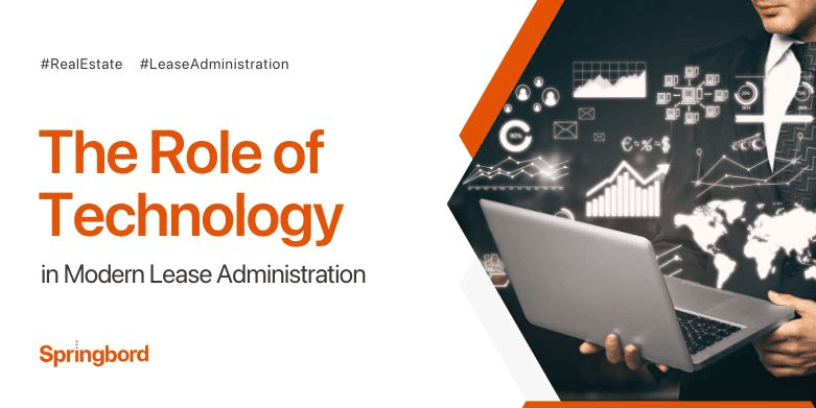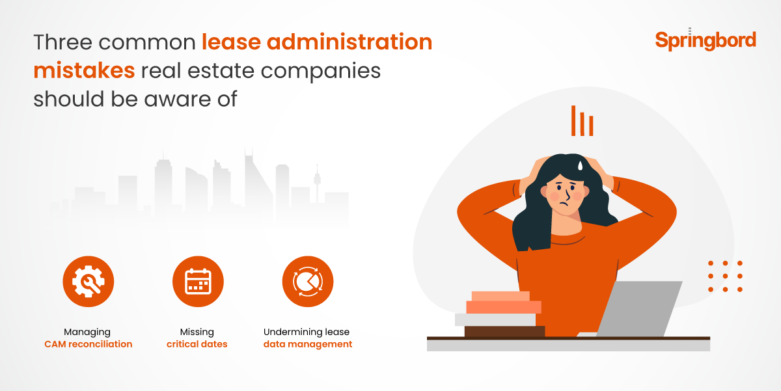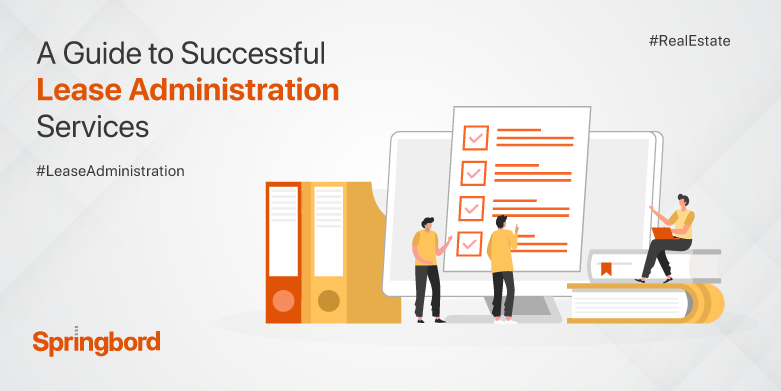 Read time 7 min
Read time 7 minLease administration, a critical aspect of real estate management, involves managing and overseeing lease agreements, tracking payments, handling documentation, and ensuring compliance.
Traditionally, lease administration has been a complex and time-consuming task, plagued by manual processes, paper-based documentation, and the potential for errors. However, the advent of technology has transformed the way lease administration is conducted, enabling businesses to optimize their operations and achieve greater productivity.
At the forefront of this technological revolution is Springbord, a leading service provider that leverages cutting-edge software and digital solutions to deliver seamless lease administration services.
II. The Evolution of Lease Administration Technology
A. Historical perspective: Traditional methods and their limitations
In the past, lease administration relied heavily on manual processes and paper-based documentation. Property owners and managers had to deal with stacks of lease agreements, amendments, and other related documents. This manual approach often resulted in inefficiencies, errors, and difficulties in accessing and analyzing lease data.
The limitations of traditional lease administration methods became evident as the volume of leases increased and businesses sought more streamlined and scalable solutions.
B. Emergence of lease management software: Advantages and impact
The emergence of lease management software revolutionized lease administration practices. These software solutions offered a range of advantages over traditional methods. They provided a centralized platform for storing and managing lease data, enabling easy access and retrieval. Additionally, lease management software offered functionalities such as automated notifications, tracking, and reporting, which improved efficiency and accuracy in lease-related tasks.
The impact of lease management software on lease administration was significant. Businesses that adopted these technologies experienced reduced administrative overheads, improved lease compliance, and increased productivity. By digitizing lease documents and automating manual tasks, organizations were able to reallocate resources to more strategic activities while minimizing the risk of errors and non-compliance.
C. Key technological advancements in lease administration
- Cloud computing and its Role in Data Accessibility and Collaboration
Cloud computing has transformed the way lease administration operates. By leveraging cloud-based lease management platforms, businesses can store lease data securely and access it from anywhere, anytime. Cloud-based solutions facilitate real-time collaboration among stakeholders, enabling teams to work on lease-related tasks simultaneously and ensuring everyone has access to the latest information. This level of data accessibility and collaboration enhances productivity and streamlines lease administration processes.
- Artificial intelligence and machine learning for automation and predictive analytics
Artificial intelligence (AI) and machine learning (ML) technologies have brought automation and predictive analytics to lease administration. AI-powered algorithms can automate repetitive tasks such as lease abstraction, data entry, and document classification. ML algorithms can analyze historical lease data to identify patterns and trends, enabling businesses to make data-driven decisions and predictions about lease performance, renewals, and potential risks. These technologies significantly reduce manual effort, improve accuracy, and enhance the efficiency of lease administration processes.
- Blockchain technology for secure and transparent lease transactions
Blockchain technology is transforming lease administration by offering enhanced security, transparency, and trust in lease transactions. Blockchain provides a decentralized and immutable ledger where lease agreements, amendments, and related documents can be stored securely. It eliminates the need for intermediaries, reduces the risk of fraud, and ensures transparent and tamper-proof lease transactions. Additionally, smart contracts built on blockchain can automate lease-related processes, such as rent payments and maintenance requests, further streamlining lease administration.
III. Streamlining Lease Administration Processes
A. Lease abstraction and data centralization
- Benefits of automated lease abstraction
Automated lease abstraction tools extract key lease data, such as rent amounts, lease terms, and renewal options, from lease documents and input them into a centralized database. This automation eliminates the need for manual data entry and reduces the risk of errors. Automated lease abstraction also enables businesses to quickly search and analyze lease data, providing valuable insights for lease management and decision-making.
- Centralized lease data repositories for easy access and retrieval
Centralized lease data repositories consolidate all lease-related information in one location, making it easy to access and retrieve critical data. These repositories provide a centralized hub for lease documents, amendments, correspondence, and other related files. By organizing and structuring lease data, businesses can improve efficiency, reduce time spent searching for information, and ensure a comprehensive view of lease portfolios.
B. Automated workflow and task management
- Efficient tracking and monitoring of lease-related activities
Automation streamlines workflow and task management in lease administration. By implementing workflow automation tools, businesses can track and monitor lease-related activities, such as rent payments, lease renewals, and compliance deadlines. These tools provide visibility into the status of each task, send automated reminders, and enable stakeholders to collaborate effectively. As a result, businesses can ensure timely completion of lease-related activities and minimize the risk of missed deadlines or non-compliance.
- Streamlined approvals and notifications
Automation also simplifies the approval process in lease administration. Instead of relying on manual routing and paper-based approvals, businesses can implement automated approval workflows. These workflows enable faster and more efficient decision-making, with notifications sent to the appropriate parties for review and approval. Automated notifications keep stakeholders informed about critical lease events, ensuring that necessary actions are taken promptly.
C. Document management and compliance
- Ensuring compliance with lease terms and regulatory requirements
Lease administration involves managing complex lease terms and ensuring compliance with regulatory requirements. Technology plays a crucial role in this aspect by providing tools for tracking and managing lease obligations. Lease management software can generate alerts and reminders for important lease events, such as rent escalations, maintenance obligations, and lease expirations. These features help businesses stay compliant with lease terms and regulatory obligations, reducing the risk of penalties and legal disputes.
- Document storage, retrieval, and version control
Effective document management is essential in lease administration. Technology solutions enable businesses to store lease documents securely and provide robust search and retrieval capabilities. Additionally, version control features ensure that the most up-to-date lease agreements and amendments are easily accessible. Centralized document repositories and version control mechanisms improve efficiency, reduce the risk of working with outdated information, and support audit trails for legal and compliance purposes.
IV. Risk Mitigation and Financial Optimization
A. Lease compliance and obligations management
In the realm of lease administration, technology plays a crucial role in mitigating risks and optimizing financial outcomes. One key aspect is lease compliance and obligations management. By utilizing advanced technology solutions, businesses gain real-time tracking and alerts for critical dates and events associated with their leases. This ensures that important deadlines such as lease renewals, rent escalations, and lease terminations are never overlooked, reducing the risk of non-compliance penalties and associated legal issues.
For instance, an automated lease administration system can send timely notifications to business owners or managers, reminding them of upcoming lease events. These notifications serve as valuable reminders, allowing them to take necessary actions within the required timeframe. By leveraging technology for lease compliance, businesses can avoid costly penalties and maintain a strong reputation for meeting their contractual obligations.
B. Lease accounting and financial reporting
Another area where technology significantly enhances lease administration is lease accounting and financial reporting. Integrating lease management systems with accounting platforms enables accurate reporting of lease-related financial information. By automating the process, businesses eliminate manual data entry errors and ensure compliance with accounting standards such as ASC 842 and IFRS 16.
The integration of technology solutions also provides improved visibility into financial performance and forecasting. Real-time access to lease data and financial metrics allows business owners to make informed decisions regarding their lease portfolio. They can assess the impact of leases on their balance sheets, evaluate financial commitments, and strategize accordingly. With accurate and up-to-date financial insights, businesses can optimize their lease portfolios and identify opportunities for cost savings and lease restructuring.
C. Lease portfolio analysis and optimization
Technology empowers businesses to analyze and optimize their lease portfolios more effectively. By leveraging data-driven insights, they can make informed decisions and maximize the value derived from their leases. Through advanced analytics tools, businesses can identify potential cost-saving opportunities, such as consolidating underutilized spaces, renegotiating lease terms, or exploring alternative leasing options.
For example, data analysis might reveal that a company has multiple leased properties in close proximity, leading to higher operational costs. By identifying this inefficiency, the business can consolidate its operations into a single location, reducing expenses and improving operational efficiency. Furthermore, technology-driven lease portfolio analysis helps businesses assess the performance of different locations, evaluate market trends, and determine the optimal mix of owned and leased properties.
V. Unlocking Strategic Advantages through Technology
A. Enhanced data analytics and business intelligence
The integration of technology in lease administration enables enhanced data analytics and business intelligence capabilities. By leveraging predictive analytics tools, businesses can optimize lease negotiations and portfolio management. Historical lease data, combined with external market trends, can provide insights into optimal lease terms, rental rates, and negotiation strategies. This allows businesses to secure favorable lease agreements and maximize their return on investment.
Furthermore, technology-driven data analytics helps identify trends, patterns, and growth opportunities within the lease portfolio. By analyzing lease data alongside market indicators, businesses can identify emerging market demands, target new customer segments, and align their lease strategies with long-term growth objectives. This data-driven approach empowers businesses to stay ahead of the competition and make informed decisions regarding their lease investments.
B. Improved tenant and landlord relationships
Technology plays a vital role in fostering improved tenant and landlord relationships. By implementing streamlined communication and collaboration tools, businesses can enhance interactions with their tenants and landlords. Online portals and automated communication systems allow for efficient sharing of lease-related documents, maintenance requests, and other important information.
Additionally, technology facilitates faster dispute resolution, ensuring that any conflicts or disagreements are addressed promptly and efficiently. With a centralized platform for communication and issue tracking, businesses can maintain strong relationships with their tenants and landlords, leading to enhanced customer experience and satisfaction. Satisfied tenants are more likely to renew their leases, reducing tenant turnover and associated costs.
C. Scalability and flexibility
One of the key advantages of utilizing technology in lease administration is the scalability and flexibility it offers. As businesses grow and their lease portfolios expand, managing leases manually becomes increasingly challenging. Technology-driven lease administration solutions provide the necessary scalability to handle a growing volume of leases efficiently.
Moreover, technology integration allows businesses to adapt to changing business needs and dynamically manage their lease portfolios. For instance, if a business decides to downsize its operations, technology can assist in identifying lease termination options, subleasing opportunities, or reconfiguring existing spaces to optimize resource utilization. By providing integration capabilities with other business systems, technology enables seamless data flow, ensuring accurate and up-to-date lease information across the organization.
Conclusion:
As the modern business landscape continues to evolve, the role of technology in lease administration cannot be understated. Companies like Springbord have embraced innovative tools and software solutions to simplify and automate the lease administration process, improving efficiency, reducing costs, and minimizing errors.
With real-time data access, enhanced document management systems, and intelligent analytics, businesses can now make informed decisions, manage their lease portfolios effectively, and focus on strategic growth.
By harnessing the power of technology, Springbord is revolutionizing lease administration, setting new industry standards, and empowering businesses to thrive in a rapidly changing world.







